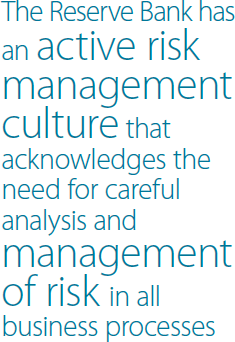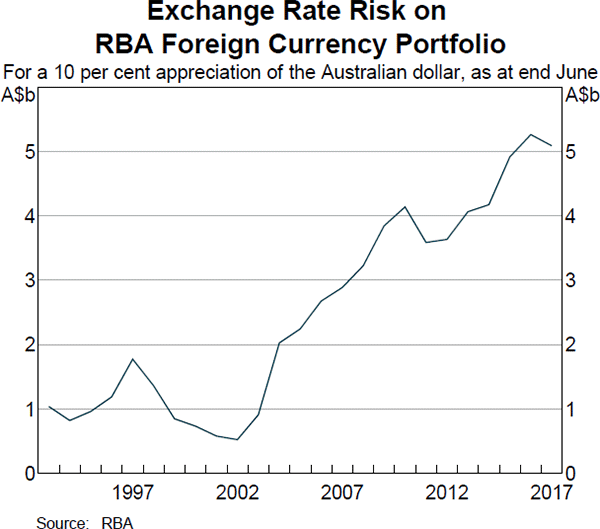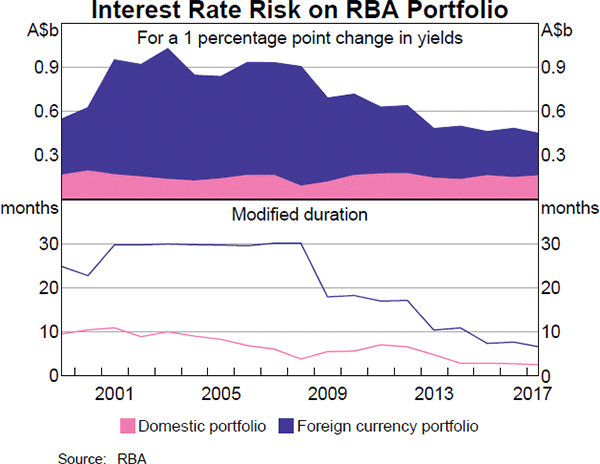Reserve Bank of Australia Annual Report – 2017 Risk Management
In meeting its objectives, the Reserve Bank takes on a number of risks. The framework through which these risks are managed is overseen by the Risk Management Committee, which is chaired by the Deputy Governor. Underpinning this framework is an active risk management culture.
Objectives and Governance Structure
In undertaking activities to support its objectives, the Reserve Bank assumes a number of risks. Management of these risks is integral to all aspects of the Bank's activities and is the responsibility of all staff. Managers have a particular responsibility to evaluate their risk environment, put in place appropriate controls and ensure that these controls are well developed and implemented effectively. The Bank identifies, assesses and manages risk at both an enterprise (‘top-down’) and business (‘bottom-up’) level, a process that is subject to ongoing review. These risks are managed to a level that is consistent with the Bank's risk appetite through processes that emphasise the importance of integrity, intelligent inquiry, maintaining high-quality staff and public accountability. The development and maintenance of an active risk management culture that acknowledges the need for careful analysis and management of risk in all business processes is an important objective of this framework.
Oversight of the Reserve Bank's arrangements for risk management is undertaken by the Risk Management Committee. The committee is chaired by the Deputy Governor and comprises: the Assistant Governors for the Business Services, Corporate Services and Financial Markets groups; the Chief Financial Officer; the Chief Information Officer; the Heads of the Audit, Human Resources, Information, and Risk and Compliance departments; and the General Counsel. The Risk Management Committee meets six times per year, or more frequently if required, and keeps the Executive Committee and the Reserve Bank Board Audit Committee informed about its activities.
The Risk Management Committee is responsible for ensuring the proper assessment and effective management of all the risks the Reserve Bank faces, with the exception of those arising directly from its monetary and financial stability policies and payments policy functions. These risks remain the responsibility of the Governor, the Reserve Bank Board and the Payments System Board. The risks associated with the Bank's shareholding in Note Printing Australia Limited (NPA) are overseen by the Reserve Bank Board and covered by the NPA Charter, although responsibility for the day-to-day activities of NPA rests with the NPA Board and management. The Bank's risk management framework covers the relationships that it has with NPA other than its shareholding – for example, joint participation in projects and the relationships of supplier, customer, landlord and tenant.

The Risk Management Committee is assisted in its responsibilities by the Risk and Compliance Department. The department's main role is to assist individual business areas to manage their risk environment effectively within a broadly consistent framework. It also monitors risk and performance associated with the Reserve Bank's activities in financial markets and supports the business areas by implementing Bank-wide control frameworks covering fraud control, anti-bribery and corruption measures, business continuity and compliance-related risks. The Head of Risk and Compliance Department reports directly to the Deputy Governor.
The Audit Department undertakes a risk-based audit program to provide assurance that risks are identified and key controls to mitigate these risks are well designed and working effectively. This includes periodic reviews of the Reserve Bank's risk management framework and testing key controls in business areas on a sample basis. The Head of Audit Department reports directly to the Deputy Governor and the Chair of the Reserve Bank Board Audit Committee.
Portfolio Risks
The Reserve Bank holds domestic and foreign currency-denominated financial instruments to support its operations in financial markets in pursuit of its policy objectives. These instruments account for the majority of the Bank's assets and expose its balance sheet to a number of financial risks. The primary responsibility for managing these risks rests with the Financial Markets Group. The Risk and Compliance Department monitors these risks and assesses compliance with approved authorities and limits. Compliance with financial management guidelines and developments in portfolio risks are reported to the Risk Management Committee.
Exchange rate risk
The largest financial risk that the Reserve Bank is exposed to is exchange rate risk as a large share of the Bank's assets are denominated in foreign currency, while most of the Bank's liabilities are denominated in Australian dollars. As holdings of foreign currency-denominated assets serve a policy function, the Bank does not seek to eliminate or hedge this exposure. Rather, the Bank mitigates the risk by diversifying foreign currency assets across various currencies. The foreign benchmark portfolio has target shares of 55 per cent in US dollars, 20 per cent in euros and 5 per cent each in Japanese yen, Canadian dollars, UK pound sterling, Chinese renminbi and Korean won (see the chapter on ‘Operations in Financial Markets’ for more detail). This benchmark portfolio composition reflects the Bank's long-term risk and return preferences and requirements for liquidity and security. The Bank's holdings of gold and Special Drawing Rights (SDRs – a liability of the International Monetary Fund) are not managed relative to an internal benchmark. The Bank's Asian Bond fund investment is managed externally by the Bank for International Settlements.

The Australian dollar value of the Reserve Bank's foreign portfolio was little changed over 2016/17. Based on the level of reserves at 30 June 2017, a 10 per cent appreciation of the Australian dollar would result in a mark-to-market loss of $5.1 billion. The increase in exchange rate risk over the previous decade and a half mainly reflects the increase in the size of net foreign exchange reserves over that period.
Interest rate risk
The value of the Reserve Bank's financial assets is also exposed to movements in market interest rates, as the bulk of the domestic and foreign portfolios comprise fixed-income securities.
Total holdings of domestic securities increased by $18.9 billion over 2016/17 to $116.6 billion. Domestic securities held on a temporary basis under repurchase agreements (repos) accounted for $102.2 billion and securities held outright accounted for $14.4 billion. The increase in outright holdings of Australian Government Securities (AGS) over 2016/17 reflected the purchase of short-dated AGS. These purchases are used to manage the liquidity impact of maturing AGS. As these securities have a very short term-to-maturity, the overall sensitivity of the domestic portfolio to movements in market yields was little changed over the period.

In contrast to the domestic portfolio, the Reserve Bank's foreign currency assets are managed relative to benchmark portfolios in each currency with duration targets that reflect the Bank's long-term appetite for risk and return. These duration targets are reviewed periodically. The duration target for the US, European, Canadian and Japanese benchmark portfolios is six months and for the UK portfolio it is three months; the Chinese and Korean benchmark portfolios have a higher duration target of 18 months. The weighted-average benchmark duration target for the Bank's foreign portfolios fell slightly over 2016/17 to around 6½ months, reflecting a reduction in the duration target of the Chinese portfolio from 30 months to 18 months. This weighted average duration target is low by historical standards, reflecting the generally low level of interest rates, which offer little compensation for the risk of capital losses should longer-term bond yields return to more normal levels.
The overall level of interest rate risk on the Reserve Bank's domestic and foreign financial assets was little changed over 2016/17. The Bank would incur a valuation loss of around $445 million if interest rates in Australia and overseas rose uniformly by 1 percentage point across the yield curve.
The Reserve Bank is exposed to very little interest rate risk on its balance sheet liabilities. Banknotes on issue account for about 37 per cent of total liabilities and carry no interest cost to the Bank. The other sizeable obligations include deposits held by the Australian Government and its agencies, and Exchange Settlement Account balances held by authorised deposit-taking institutions (ADIs). These deposits have short maturities that broadly match the Bank's domestic assets held under repo. Interest paid on these deposits reflects domestic short-term interest rates, effectively hedging part of the interest rate exposure of the domestic asset portfolio.

(Left) Banknote Ethics Initiative Principal Advisor Antti Heinonen; Reserve Bank Assistant Governor (Business Services) Lindsay Boulton (centre) and Crane Currency CEO Stephen DeFalco at a panel discussion on managing ethical risk at the Currency Conference, Kuala Lumpur, May 2017
Credit risk
Credit risk is the potential for financial loss arising from the default of a debtor or issuer, or from a decline in asset values following a deterioration in their credit quality. The Reserve Bank manages its credit exposure by applying a strict set of criteria to its holdings of financial assets and confining its dealings to highly creditworthy counterparties. In addition, the Bank's transactions are executed under internationally recognised legal agreements.
The Reserve Bank is exposed to very little issuer credit risk on its outright holdings in the domestic portfolio as it invests only in securities issued by the Australian Government or by state and territory government borrowing authorities. The Bank is exposed to a small amount of counterparty credit risk on domestic assets that are held under repo. The Bank would face a loss only if a counterparty failed to repurchase securities sold under repo and the market value of the securities fell below the agreed repurchase amount. The Bank manages this exposure by requiring that these securities meet certain eligibility criteria, and applying an appropriate margin to the securities, which is maintained throughout the term of the repo through two-way margining. The degree of over-collateralisation increases with the risk profile of the security. The Bank widened the eligibility criteria for longer-term ADI-issued securities in June 2017, but applied higher haircuts to the newly eligible securities (see the chapter on ‘Operations in Financial Markets’ for more detail).
The Reserve Bank does not apply credit ratings-based criteria to the counterparties with which it is willing to deal in carrying out policy operations in the domestic market. However, counterparties must be subject to an appropriate level of regulation and be able to ensure efficient and timely settlement of transactions within the Austraclear system. Repo transactions with the Reserve Bank are also governed by a Global Master Repurchase Agreement as part of the Reserve Bank Information and Transfer System (RITS) Regulations.
Investments in the Reserve Bank's foreign currency portfolio are typically confined to highly rated and liquid securities, as well as deposits with foreign central banks. The majority of the Bank's outright holdings are securities issued by the national governments of the United States, Germany, France, the Netherlands, Japan, Canada, the United Kingdom, China and South Korea, with modest holdings of securities issued by select highly rated supranational institutions and government agencies.
The Reserve Bank also holds a portion of its foreign currency portfolio in short-term repos. This exposes the Bank to the small amount of residual credit risk that is inherent in repos, as noted above. The Bank manages this risk by requiring 2 per cent over-collateralisation, which is maintained through two-way margining, and accepting only high-quality and liquid securities as collateral. Credit exposure on foreign repos is further managed by imposing limits on individual counterparty exposures and requiring execution of a Global Master Repurchase Agreement (or Master Repurchase Agreement where appropriate) with each counterparty.
The Reserve Bank undertakes foreign exchange swaps as part of its policy operations and as a means to enhance returns on the foreign currency portfolio. Credit risk on these instruments is managed by transacting only with counterparties that meet strict eligibility criteria, including the requirement to have executed with the Bank an International Swaps and Derivatives Association (ISDA) agreement with a credit support annex.
Exposures on foreign exchange swaps generated by movements in market exchange and interest rates are managed through two-way margining.
Operational Risks
There are a diverse range of operational risks associated with the Reserve Bank's day-to-day activities. These risks range from software failure following system implementations to unauthorised access to systems and data, as well as the unintentional disclosure of confidential and sensitive information. Generally, the Bank has a low appetite for this type of risk. The Bank recognises that it cannot eliminate risk entirely from its operations and acceptance of some risk is often necessary to foster innovation and efficiencies in business practices.
While all parts of the organisation are exposed to operational risk of varying degrees, the most significant risks are those associated with financial transactions undertaken by the Reserve Bank for its own activities and that of its clients. During 2016/17, Financial Markets Group executed around 68,000 transactions, generating an average daily settlement value of around $32 billion. The Bank is also the primary banker for a number of government entities, including the Australian Taxation Office and Department of Human Services, and it maintains the infrastructure to facilitate real-time interbank payment and settlement services through RITS. Given the crucial role of these activities in the financial system, any operational failure could have widespread consequences. As a result, the Bank has in place a range of processes to facilitate ongoing and effective management of its operational risks in order to maintain a suitably robust control environment.
Extensive back-up plans have been established to ensure the continuity of critical business functions during and after a disruptive event such as a natural disaster, power outage or terrorist attack. These plans include the use of a dedicated Business Resumption Site (BRS) in north-west Sydney, where permanent staff from some of the Reserve Bank's most critical operational areas are located. All departments regularly test their back-up plans at the site, including combined exercises involving multiple areas to test the capacity of the facilities. Additionally, staff at the Bank regularly test back-up plans in a work-from-home environment, which covers scenarios where the Head Office and BRS may both be unavailable, such as a pandemic or transport disruption. The Bank also liaises with external organisations on business continuity matters, including participating in shared exercises to ensure that staff are well briefed in their roles during disruptions and that effective internal and external communication arrangements are in place. The results of exercises are monitored by the Risk Management Committee.
The Reserve Bank's policy and business operations are highly dependent on information technology (IT) systems. The Bank's risk management framework supports an ongoing focus on managing the risks associated with complex IT systems. A key element of this framework is the operation of the Technology Committee, which is chaired by the Assistant Governor (Corporate Services). This committee collaborates with relevant business areas to facilitate the monitoring, assessment and management of IT-related risks and ensure IT-related initiatives are consistent with the Bank's IT strategy. This work is supported by the continuous evaluation of industry developments in order to ensure that the Bank's systems conform to current IT standards and remain robust. Assessment of appropriate staff resourcing, the adequacy of controls over IT processes and the level of security over information management are all incorporated into the Bank's risk management framework.
During 2016/17, the Reserve Bank continued to direct significant resources towards the delivery of a number of large and complex multi-year projects. These include the renovation of banking applications and systems, the development of infrastructure to facilitate real-time retail payments and the upgrade of Australia's banknotes. Successful completion of these projects will ensure high-quality services are maintained for the Bank's clients and the Australian public. The risks associated with project work are carefully managed so that adequate resources are available, nominated project deadlines are met and change management is effective. Project steering committees play an important role in overseeing the management of these risks.

The Reserve Bank has no tolerance for fraud or other unethical behaviour. All staff involved in financial dealing have well-defined limits to their authority to take risks or otherwise commit the Bank. These arrangements are further enhanced by separate front-, back- and middle-office functions, where staff involved in trading, settlement and reconciliation activity remain physically separate and have separate reporting lines. For non-trading activities, several layers of fraud controls are in place, including preventative, detective and corrective controls. A clear decision-making hierarchy, separation of duties and physical controls over systems and information are evident and are subject to regular review. Ongoing training and awareness programs are also conducted. In March 2017, the Bank rolled out a face-to-face Fraud Awareness training program for all staff. The Bank has arrangements in place for staff and members of the public to report concerns anonymously, and all concerns are fully investigated. During 2016/17, there was one reported instance of fraud against the Bank by an employee.
The effective management of compliance risk is central to the Reserve Bank's activities. Risk and Compliance Department collaborates with all business areas to ensure that this risk is being managed effectively and keeps the Risk Management Committee informed regarding the level of compliance in key areas. Staff also complete a number of compliance-based electronic training modules each year, focusing on areas such as privacy and workplace health and safety.

The Reserve Bank remains strongly committed to maintaining and strengthening a workplace culture in which employees uphold the highest standards of behaviour. A Code of Conduct is in place that sets out requirements of the Bank's employees and others who are involved in its activities. The code articulates the values that staff are expected to demonstrate when pursuing the Bank's objectives. These values require employees to conduct themselves with a high degree of integrity, strive for excellence in the work they perform, treat others with respect and courtesy, exercise intelligent inquiry and promote the public interest. All staff attest annually that they have read and understood the code.
Operational failures can occur from time to time regardless of a strong control framework. These occurrences may adversely affect the Reserve Bank's reputation or lead to financial or other costs. Timely reports on any such incidents are distributed to the Risk Management Committee, summarising the relevant circumstances and identifying areas where new controls may be needed or where existing controls should be strengthened.
Government Guarantee Scheme
The Reserve Bank continues to act as the administrator of the Guarantee of State and Territory Borrowing. Applications for new guaranteed liabilities under this scheme closed in 2010, although existing liabilities will continue to be guaranteed until maturity, at the latest in 2023. To date, a total of $410 million in fees has been collected for state and territory borrowing since the scheme commenced in 2009, with $14 million collected in 2016/17.